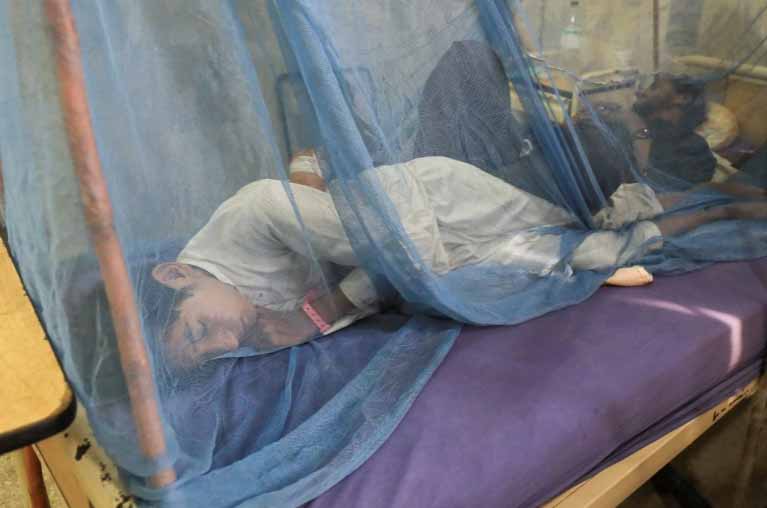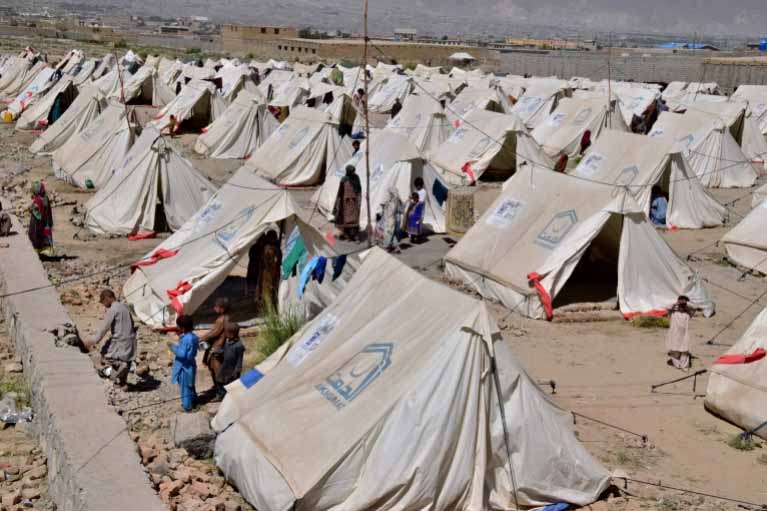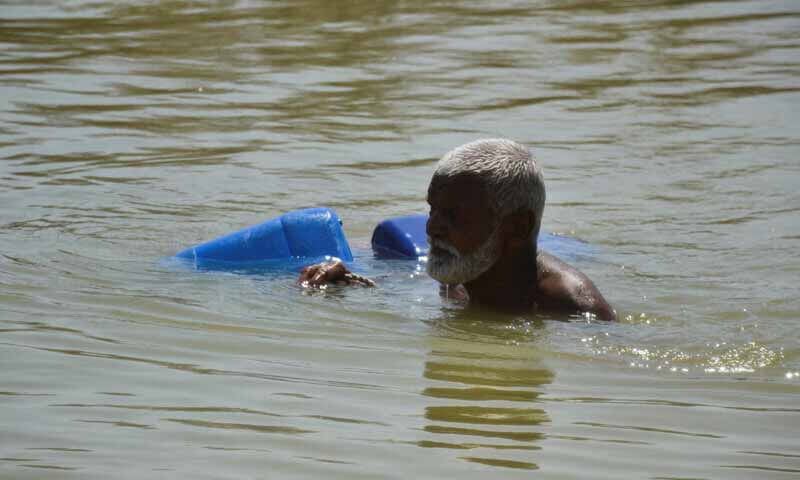6 more die of gastro, other illnesses amid rising disease incidence in Sindh’s flood-hit areas

Nine die of gastroenteritis, diarrhoea and malaria in Sindh in the last 24 hours as the crisis overwhelms the country’s health system.

A dengue fever patient lies under a mosquito net at Lady Reading Hospital in Peshawar
Islamabad, Pakistan – Water-borne diseases are a new concern in flood-ravaged Pakistan, with the authorities reporting at least nine such deaths in the last 24 hours, according to government data.
All the deaths caused by diarrhoea, malaria and gastroenteritis were reported in the southeastern Sindh province where more than 300 people have died of flood-related ailments since July.
Sindh officials said more than 500,000 people are still displaced by the calamity and living in makeshift camps across the province.
Meanwhile, the National Disaster Management Authority (NDMA) on Tuesday said the death toll in the catastrophic floods has risen to 1,559.
Pakistan was battered by record rains and melting glaciers beginning in the middle of June. The floods at one point submerged one-third of the nation of 220 million people, destroying more than a million homes and dozens of roads, railways and bridges.
The government, already facing an economic crisis, estimates the total financial losses due to the floods at $30bn and has appealed to the global community for help.

Floods victims stand beside their tents at a relief camp in Dasht near Quetta
Officials in Sindh, home to 48 million people, said more than 137,000 cases of diarrhoea, over 10,000 cases of dysentery and at least 4,000 confirmed cases of malaria were reported in the province this month, adding that they have set up 450 medical camps to tackle the health crisis.
“The biggest challenge we are facing is because of malaria and gastroenteritis. We don’t have enough protective nets or medical kits to detect malaria. Relief organisations and the government are regularly supplying us with required material but the magnitude of the problem is just so huge,” Amjad Mastoi, a health official in Sindh’s Dadu district told.
Shahnawaz Solangi, a 53-year-old teacher in Sindh’s Naushero Feroz district, said his family was not receiving much help from the government.
“Two of my children, 12 and 18 years old, have malaria for the last two weeks. We have run out of tablets. The fever breaks at times but returns in the evening,” he told.
Solangi said his family of 12 members is living in a makeshift house they built on higher ground after their village was swept away a month ago. “We don’t have any family in other cities so we along with few others from our village decided to stay back,” he said.
Last week, the World Health Organization (WHO) chief Tedros Adhanom Ghebreyesus warned of a looming health disaster in Pakistan.
“I am deeply concerned about the potential for a second disaster in Pakistan: a wave of disease and death following this catastrophe, linked to climate change, that has severely impacted vital health systems leaving millions vulnerable,” he said in a statement.
The WHO chief said pregnant women were at risk in the affected areas. “All this means more unsafe births, more untreated diabetes or heart disease, and more children missing vaccination, to name but a few of the impacts on health,” he said.
The United Nations Population Fund in August cautioned that more than 650,000 pregnant women in flood-affected areas require urgent maternal health services, with at least 73,000 women expected to give birth in September.
Dr Khalid Memon, a health official in Sindh, told Al Jazeera they are compiling data on pregnant women taking refuge in makeshift camps.
“Our district health officers are deployed across all the affected areas and so far we have registered at least 9,500 pregnant women,” he said, adding that expecting mothers were being given food supplements and anti-tetanus vaccines.
Sindh’s health minister Dr Azra Fazal Pechuho said many villages remain inaccessible and a true picture of the spread of disease and displacement of people will only emerge once the waters recede.
“Floods have drowned most roads and highways … Boats are being deployed as not just means to rescue people but also as mobile health camps,” she told.
“We are also asking medical universities to send their final-year students for assisting in flood relief efforts.”
‘Complete de-watering may take months’: Memon
Record monsoon rains and glacial melt in Pakistan have triggered the flooding that has impacted nearly 33 million people, sweeping away homes, crops, bridges, roads and livestock in damages estimated at $30 billion.
While vast swathes of land remain inundated in Sindh, officials and reports have been saying that water levels have begun to recede in the province.
However, Sindh Information Minister Sharjeel Memon says it might take months to completely drain the water.
The water level had reduced in Kotri Barrage, while the teams of the irrigation department were also working on de-watering water elsewhere, however, it might take months to completely drain the water, he said during a press conference in Karachi on Wednesday.
“Low-lying areas can only be de-watered through pumping and it is a tough task to take machines to those areas, but the government is trying its best to do this,” he said.

A man, displaced because of the floods, wades through flood water to fill the canisters, following rains and floods during the monsoon season in Sehwan, on September 20, 2022
Separately, Dadu Deputy Commissioner Murtaza Ali Shah told that water levels had dropped further in flood-hit areas of the district.
“Water levels have fallen by around three-and-a-half feet in Mehar, Johi and Khairpur Nathan Shah,” he said, adding that however, floodwater was standing at around nine feet in most villages of the districts and some areas of Khairpur Nathan Shah.
Moreover, Dadu Assistant Commissioner Shahnawaz Merani said water was standing up to nine feet after receding by around three feet at Main Nara Valley Drain in the district.
Meanwhile, the Flood Forecasting Division website showed that the River Indus was witnessing a low-level flood at Kotri on Wednesday afternoon.
A delegation from the European Union visited villages in Khyber Pakhtunkhwa’s Nowshera and posted photographs of their interactions with officials and locals.
#FloodsInPakistan affected millions of families. Today Members of 🇪🇺 @Europarl_EN visited villages in 🇵🇰Nowshera to meet affectees and show solidarity in this difficult time.
🇪🇺continues to support 🇵🇰 through humanitarian aid and civil protection mechanisms. #TeamEurope pic.twitter.com/bCPmOOr5nJ— EUPakistan (@EUPakistan) September 21, 2022
Relief efforts
While addressing the press conference, Memon also said that the provincial government was providing meals to millions of people in Sindh on a daily basis.
“As many as 688,712 families have been given ration bags and the process is continuing. Similarly, around 737,572 litres of drinking water have been provided to flood-affected people,” he added.
In response to a question, Memon said the provincial government had set a wheat support price at Rs4,000. He added that the imported wheat cost the government Rs9,000, hence it was better for people to buy it locally instead of opting for an import.
He insisted that wheat was not a profitable crop, saying the government took all decisions to prevent the occurrence of a food crisis-like situation in the country.
PM calls for collective action to deal with climate change
Later, Prime Minister Shehbaz Sharif urged citizens to continue to make donations for flood-hit individuals and families and said in meetings with world leaders, he had called for collective action to deal with climate change.
The prime minister, who is in New York to attend the 77th session of the United Nations General Assembly, said in a video message that he had been informed about baby food shortage during a virtual meeting on the flood situation.
“I was told in the meeting that there is a shortage of baby food. Hence, I appeal to the affluent and especially to baby food manufacturers … to supply it to the NDMA, PDMA, armed forces or through any other means to flood-affected people,” the prime minister said, adding that such efforts would help ensure “satisfactory arrangements” for the provision of baby food among the flood-hit population.
Moreover, he said he had spoken about the devastation caused by floods in meetings he had held in New York earlier in the day and highlighted the economic difficulties the country had been facing as a result of the devastation.
New York: Prime Minister Muhammad Shehbaz Sharif’s exclusive talk about the ongoing flood relief activities in the country.
1/3 pic.twitter.com/U71QCph1ZH— Prime Minister’s Office (@PakPMO) September 21, 2022
On Tuesday, Planning and Development Minister Ahsan Iqbal, who is also the deputy chairperson of the National Flood Response and Coordination Centre, announced that a campaign would be launched for collecting two million packets of food for women and children affected by floods.
He said in a tweet that the campaign would be carried out in collaboration with university students.
“Two-thirds of the country has to support one-third of the population. Undoubtedly, the calamity of floods is huge but not bigger than the courage and determination of the Pakistani nation,” he added.
More aid flows in
Meanwhile, Pakistan received the first consignment of aid from Russia today, according to a Radio Pakistan report.
The flight, which landed at the Jinnah International Airport in Karachi, consisted relief goods such as flood items, tents and water cleaning devices.
The consignment was received by Russian Consul General in Karachi Fedorov Andrey, Advisor to Chief Minister on Relief and Rehabilitation Rasool Bux Chandio and representatives of NDMA and Ministry of Foreign Affairs.
Separately, the first flight of relief good from Greece landed in the metropolis as well.
The consignment was received by Honrary Council of Greece in Pakistan Ayaz Mohammad Lakhani along with other representatives. Foreign Office Spokesperson Asim Iftikhar, in a statement, said: “Relief assistance from Greece is welcomed with warmth and gratitude.”

Hey! My name is Mahnoor and I joined Rangeinn as the content & News Writer. Currently, I’m doing my Bachelors in International Relations.









